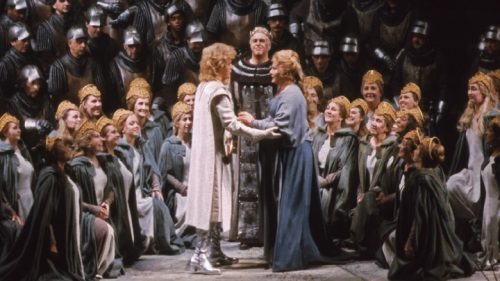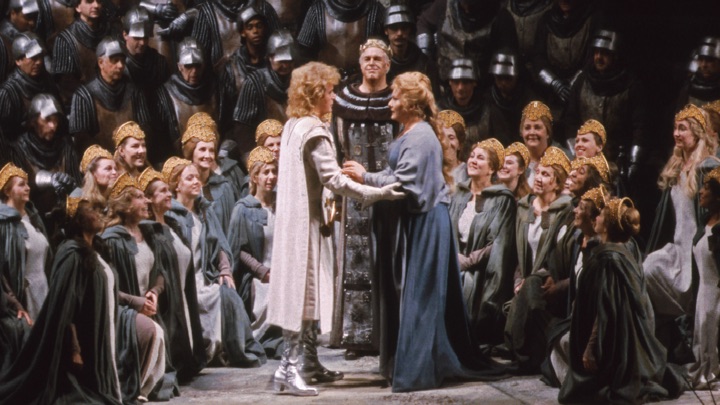 United States Wagner, Lohengrin: Soloists, Chorus and Orchestra of the Metropolitan Opera, New York / James Levine (conductor). 10.1.1986 performance from the Metropolitan Opera House reviewed as a Nightly Met Opera Stream on 20.5.2020. (JPr)
United States Wagner, Lohengrin: Soloists, Chorus and Orchestra of the Metropolitan Opera, New York / James Levine (conductor). 10.1.1986 performance from the Metropolitan Opera House reviewed as a Nightly Met Opera Stream on 20.5.2020. (JPr)

Production:
Production – August Everding
Set designer – Ming Cho Lee
Costume designer – Peter J. Hall
Lighting designer – Gil Wechsler
TV Director – Brian Large
Cast:
Lohengrin – Peter Hofmann
Elsa – Éva Marton
Ortrud – Leonie Rysanek
Telramund – Leif Roar
King Heinrich – John Macurdy
Herald – Anthony Raffell
Gottfried – Christian Collins
Four Nobles – Charles Anthony, John Darrenkamp, John Gilmore, Richard Vernon
In his Met ‘Weekly Guide’ Jay Goodwin introduces this 1986 Lohengrin as follows: ‘Due to the quirks of scheduling and some unanticipated technical challenges, Wagner’s lush, Romantic tale of a holy knight and the maiden who loves him has not seen the Met stage since 2006, making this Nightly Opera Stream the first Met presentation of Lohengrin in more than 14 years.’ Before the Met closed its doors it was planned for François Girard to bring his new Lohengrin from the Bolshoi to the Met in 2023 with Anna Netrebko and Piotr Beczala as Elsa and Lohengrin, but who knows now?
August Everding’s 1976 production – with sets by Ming Cho Lee and costumes by Peter J. Hall – proved the perfect fantasy Lohengrin. There were monumental sets from Ming Cho Lee and costumes – military uniforms, thick robes, regalia, and all – from Peter J. Hall. Adding in two perfectly coiffured blond leads – often seen in bejewelled white – this would have served a ‘Golden Age’ Broadway Camelot more than adequately. During the many times I visited Vienna in my student days I revered their Parsifal which dated from 1979 (and so overlapped with this Lohengrin). Vienna State Opera’s tree-lined Transformation Scenes from Everding and his designer Jürgen Rose had to be seen to be believed, making that a Parsifal of one’s dreams too.
Even if you do not know either production you will probably appreciate how deeply traditional Everding was. However, he was not so literal as to have a swan in this Lohengrin which was attractive and far from challenging: Hans Neuenfels’s rat-infested Bayreuth Lohengrin (review click here) it most certainly is not. Lohengrin does get to hand over a horn, jewel-encrusted sword, and a ring to Elsa before departing at the end of Act III. (Thankfully, he had no need of a shield earlier for the wedding night as a tenor once so famous needed at Covent Garden for ‘protection’. If he forgot his words, they were written on it!)
Nevertheless, the stage pictures we see in this Met Lohengrin could have been lifted directly from pre-Raphaelite paintings of King Arthur and the Arthurian legends. Okay, so what if it is very kitschy? There is an Act I wooden stockade on the banks of a river with a large totem seen to indicate their pagan beliefs are not too far in the past; despite the Christian symbolism elsewhere in what we see and hear. Act II initially has a huge stage deep wall with a Juliet balcony where Elsa will appear and later some large steps possibly leading down from a cathedral. Act III begins in a silk-draped bedroom with an ornate four-poster bed before reverting to what we saw in Act I.
So, what can we be taught in 2020? Firstly, the standard of directing these live opera broadcasts has declined since 1986 if this is an example for how it was done then. Brian Large allowed the story to unfold clearly and be as involving as possible. I am happy to overlook all the ‘scenery-chewing’ from the principal singers. So, regardless of how much wide-eyed melodramatic emoting there was, I saw a quintet of real personalities in a Lohengrin that benefitted from the widescreen cinematic techniques Large employed. Never – and I mean never – have I seen a singer shed as many real tears as Éva Marton’s Elsa did in several close-ups. Have I ever seen a singer – female or male – appear so emotionally engaged on screen with the role they were singing, I am not sure? Also, Leonie Rysanek gave a masterclass in pent-up vengeful anger as the sorceress Ortrud who is skilled in the black arts, and is determined to come between Elsa and her saviour, Lohengrin. Finally, among many other highlights, how wonderful it was to have Peter Hofmann’s swan knight filmed at the back of the stage from below as he bade farewell (‘Mein lieber Schwan’).
As for the singing, it would be as easy to disparage that as easily as the acting we see, but you would be wrong. In 2020 there is certainly not the depth of Wagnerian talent there was in the late-twentieth century. Peter Hofmann was a handsome, emotionless, Lohengrin and few in the history of opera looked more suited for the role they sang. Sadly, in about three years he became a full-time pop singer. In five more, he would be diagnosed with Parkinson’s disease which subsequently ended his career and contributed to his early death in 2010 at only 66.
There just might possibly have already been an onset of Hofmann’s vocal decline in 1986 and I do remember him being mercilessly booed at Bayreuth around the same time. But through my (good) laptop headphones he sounded no worse than any Lohengrin you might hear today. ‘In fernem Land’ was a little bit of a struggle – when isn’t it? – although the crucial word ‘Taube’ was beautifully controlled. I got the impression of – from today – Klaus Florian Vogt’s crystal clear, piping, tones that Hofmann was unnaturally trying to darken and as a result his voice sometimes lacked momentary security. He was helped to bring his performance to a fine conclusion by a substantial cut after his Act III Narration that was traditional at the time in many opera houses, though not Bayreuth. The excision began when Elsa fainted after Lohengrin revealed his name and ended just prior to the chorus’s ‘Der Schwan! Der Schwan!’ outburst.
I found Leif Roar’s baritone – singing as the put-upon Telramund – more smoothly lieder-like than we often hear now. Certainly, he would have made a fine bug-eyed henchman in the silent movie era. John Macurdy (who sadly died earlier this month) was stoically impassive as King Henry and matched Anthony Raffell’s Herald in stentorian projection.
Veteran Leonie Rysanek (who died in 1998) was both imperious and psychotic! The wildness of her portrayal was mirrored in her singing which had its shrill moments that seemed totally in character. (In current times, only Petra Lang can convincingly get away with what Rysanek did as Ortrud.) Éva Marton’s Elsa began with a trance-like piety before becoming increasingly insecure and conflicted. She was not the type of singer who would normally be cast as Elsa in the 2020s, Netrebko notwithstanding. However, sounding like Sieglinde – or even a Verdi heroine – Marton was the powerful central and dramatic focus of this Lohengrin. Her lack of vulnerability made her all the more believable as Elsa, and her musicianship was exemplary.
The Met’s chorus and orchestra did not disappoint, but the TV director Brian Large could be criticised for all the unnecessary close-ups of James Levine during the three orchestral preludes. Nevertheless, Levine conducted – from memory it seemed – a lovingly-shaped and luminous account of the score. Here and there his tempi quickened, but, in general, the conductor revealed a gift for maintaining Lohengrin’s over-arching shape and he never allowed the forward momentum to sag.
Jim Pritchard
For more about the Nightly Met Opera Streams click here.
